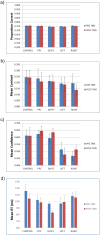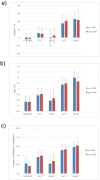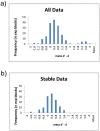Theta-burst transcranial magnetic stimulation to the prefrontal or parietal cortex does not impair metacognitive visual awareness
- PMID: 28192502
- PMCID: PMC5305100
- DOI: 10.1371/journal.pone.0171793
Theta-burst transcranial magnetic stimulation to the prefrontal or parietal cortex does not impair metacognitive visual awareness
Abstract
Neuroimaging studies commonly associate dorsolateral prefrontal cortex (DLPFC) and posterior parietal cortex with conscious perception. However, such studies only investigate correlation, rather than causation. In addition, many studies conflate objective performance with subjective awareness. In an influential recent paper, Rounis and colleagues addressed these issues by showing that continuous theta burst transcranial magnetic stimulation (cTBS) applied to the DLPFC impaired metacognitive (subjective) awareness for a perceptual task, while objective performance was kept constant. We attempted to replicate this finding, with minor modifications, including an active cTBS control site. Using a between-subjects design for both DLPFC and posterior parietal cortices, we found no evidence of a cTBS-induced metacognitive impairment. In a second experiment, we devised a highly rigorous within-subjects cTBS design for DLPFC, but again failed to find any evidence of metacognitive impairment. One crucial difference between our results and the Rounis study is our strict exclusion of data deemed unsuitable for a signal detection theory analysis. Indeed, when we included this unstable data, a significant, though invalid, metacognitive impairment was found. These results cast doubt on previous findings relating metacognitive awareness to DLPFC, and inform the current debate concerning whether or not prefrontal regions are preferentially implicated in conscious perception.
Conflict of interest statement
The authors have declared that no competing interests exist.
Figures





References
-
- Koch C, Massimini M, Boly M, Tononi G. Neural correlates of consciousness: progress and problems. Nat Rev Neurosci. 2016;17(5):307–21. http://www.nature.com/nrn/journal/v17/n5/abs/nrn.2016.22.html#supplement.... 10.1038/nrn.2016.22 - DOI - PubMed
MeSH terms
LinkOut - more resources
Full Text Sources
Other Literature Sources
Miscellaneous

